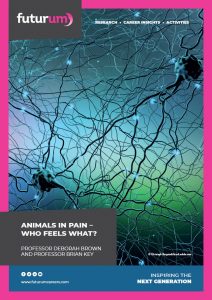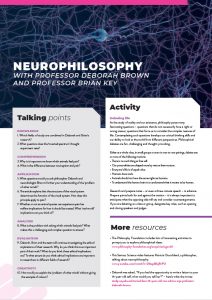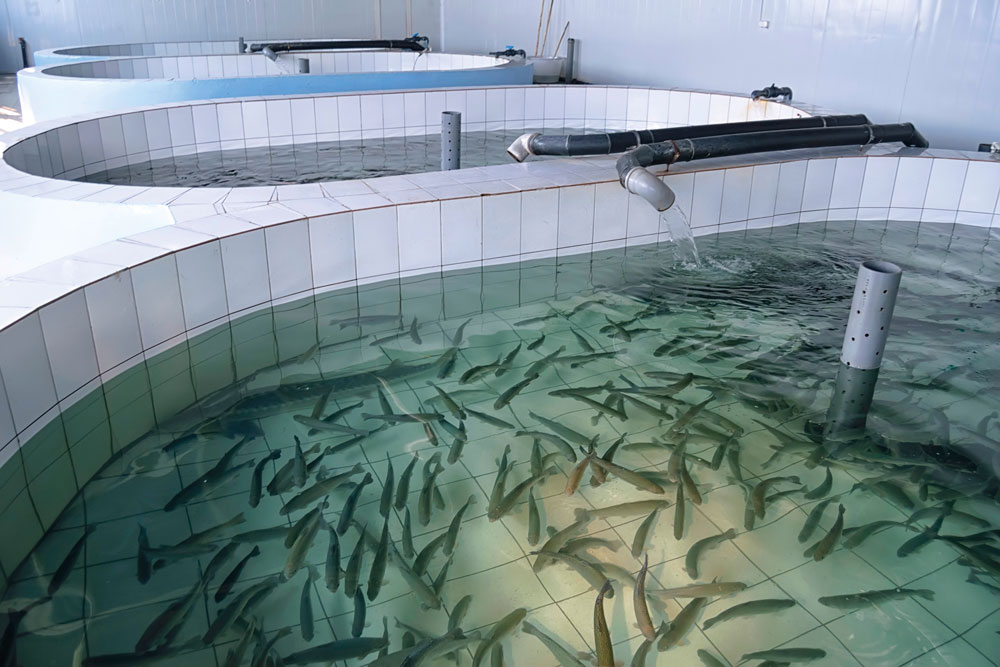Animals in pain – who feels what?
At The University of Queensland in Australia, Professor Deborah Brown and Professor Brian Key have created a unique team of philosophers and neuroscientists to investigate which animals have the capacity to feel pain.
TALK LIKE A … NEUROPHILOSOPHER
Analogous structures — examples of convergent evolution. For example, butterfly wings and bird wings are analogous structures
Cerebral cortex — the outer layer of the brain, responsible for language, memory and decision-making (among other processes)
Convergent evolution — where two distinct species have evolved a similar physiological structure from different ancestors
Epistemology — the area of philosophy which examines the foundations for knowledge and justification
Homologous structures — similar structures that have evolved from a common ancestor. For example, the whale flipper and the bat wing have skeletal similarities which are evidence that their common ancestor had a forelimb complete with humerus, radius and metacarpals
Necessary condition (for X) — a condition which must be fulfilled in order that X can occur. For instance, it is a necessary condition for sodium that each atom in a sample has eleven protons. In contrast, it is not a necessary condition for sodium that each atom in a sample has eleven electrons (ions of sodium in a solution have ten electrons)
Neurophilosophy — the interdisciplinary study of neuroscience (the study of the brain and nervous system) and philosophy (the study of knowledge, reason and how humans understand their existence in the world)
Nociception — the process by which damaging (noxious) stimuli are communicated in the nervous system. This involves the transmission of information about damaging chemical, mechanical and thermal stimuli from the peripheral nervous system to the brain
Pain — the brain’s awareness of nociception that is experienced as an unpleasant feeling
Quadruped — an animal that walks on four feet
Sentience — the ability to experience feelings and sensations
Animals have evolved a remarkable range of species-specific behaviours. For example, birds can use their forelimbs to fly in the air, while quadrupeds use them to run across the ground. One of the most challenging problems in biology is understanding what motivates animals to perform such behaviours. Is it because, like humans, they have sensory experiences of pleasure and pain? Do they fly away or run from environmental stimuli due to pain, and do they seek the warmth of sun because of pleasure?
How can we know what other animals experience? How can we even know whether other animals experience anything at all? Questions like these sit at the intersection of science and philosophy, and Professors Deborah Brown and Brian Key, Dr Oressia Zalucki (postdoctoral fellow) and Jacob Taylor (PhD student) from The University of Queensland are addressing them using a mix of scientific and philosophical methods. The answers to these questions are extremely important practically and theoretically. For example, whether an animal feels pain informs the way we treat that animal in agriculture and research settings. It has implications for the food security of many, particularly developing, nations, and it informs our general understanding of one of the great mysteries of the Universe: consciousness.
What is the philosophical problem of other minds?
A long-standing problem in epistemology is the ‘problem of other minds’. Its most basic form is captured in the question ‘How do you know that there are any minds other than your own?’ You will only ever have direct, conscious access to your own mind, so how do you know that the people around you (who you think have minds) are not just sophisticated zombies or robots? Even if you are sure other people exist and have minds, you might still wonder if their experiences are like your own. This leads to other questions such as ‘How do you know that someone else’s experience of green and red is the same as yours?’ After all, you never see how green and red things look to anyone else. You describe grass as ‘green’ and strawberries as ‘red’, but these are labels attached to private experiences which you can never compare against the experiences of anyone else. The sky that looks blue to you might look like the colour of a ripe banana to others. This is known as the ‘inverted spectrum’ thought experiment, and it is one example of a general problem that arises because experiences are private to those who have them.
Reference
https://doi.org/10.33424/FUTURUM325
How does biological structure determine function?
It is a simple truth that without specialised light-detecting cells called photoreceptors, you cannot see. Humans with certain eye conditions gradually go blind as the photoreceptor cells within their eyes die, so we can say that photoreceptor cells are a necessary condition for normal vision. Neurobiologists know a great deal about the way the visual system works and can explain necessary conditions for vision. For example, people who are colour blind are missing certain proteins in their photoreceptor cells; these cells can no longer react to the full spectrum of colour normally experienced. The structure of the visual system – beginning with proteins in the photoreceptor cells – determines the functions the visual system can perform.
What does this have to do with animal pain?
Like colour blindness in the visual system, there are disorders in the pain system which can tell us about the necessary conditions for pain. For example, people with a disorder called congenital insensitivity to pain are born without the ability to feel pain. Although this might sound like a beneficial condition, it is actually very dangerous. For example, a sufferer could drink a hot beverage and scald their mouth without being aware of it. The nerve cells that would normally respond to damaging injuries are dysfunctional due to the altered structure of a protein necessary for sensing in these cells. The structure of the nervous system is important for explaining sensory function.
And what about convergent evolution?
Convergent evolution may result in analogous structures – that is, distinct species may evolve similar biological structures. The challenge here is to analyse the structures at an appropriate level of description. While it is true that butterfly wings and bird wings evolved independently of one another, both must obey the principles of aerodynamics for the animal to fly. The structure of the wing still determines the function of the wing, so whether the structure is homologous or analogous, it is the sameness of structure that explains the sameness of function.
What is the difference between nociception and pain?
Another complicating factor in the question “Which animals feel pain?” is the distinction between nociception and pain. Nociception is the non-conscious signalling in the nervous system that takes place following a noxious (tissue damaging) stimulus. There is no feeling of pain with nociception. A common example is a simple reflex where you quickly withdraw your hand from a hot surface before any feeling of pain. There is a noticeable lag between the quick nociceptive responses (which are mediated by short spinal pathways) and pain (which involves the longer pathways that traverse from the spinal cord to the brain). For an animal to experience pain, it needs the nociceptive structures as well as homologous or analogous brain structures that process nociception into pain.
Which animals feel pain?
Answering this question requires the neurophilosopher to answer the question “What is the right level of description of structures which determine the functions responsible for pain?” Is it enough to say that an animal has a nervous system, or a central brain, or do we have to be more specific? This involves juggling several complicated sub-questions such as “Which are the neural structures responsible for pain in humans?” and “What are the presumed analogical structures in animals?” It also requires thinking about the philosophical assumptions we make when we try to answer such questions. For example, is the meaning of ‘pain’ tethered to a certain kind of structure or, as many philosophers and scientists think, could it be attached to very different kinds of structures?
What conclusions has the team reached, so far?
In their project, Deborah, Brian and their team argue that a nervous system must be capable of performing a certain kind of neural computation – which they refer to as the parallel forward models algorithm – by means of which the organism is aware of their brain’s nociceptive processing and without which an organism is not able to feel pain. In arguing this, the team has had to defend not just the science behind the model but also philosophical theories, including the idea that sometimes an absence of evidence for the existence of something is evidence of its absence. Deborah and Brian have also had to defend the idea that nociception and pain are distinct kinds of phenomena and that evidence for the first is not sufficient evidence for the second. While evidence suggests that mammals meet the structural requirement to support their brains’ awareness of nociceptive processing, no analogous structure has been shown to exist in fish, molluscs or insects.
What are the next steps?
The team is embarking on an ambitious project that involves investigating sentience in different species, the evolution of that sentience and the ethical implications of their research. Whether or not an animal species can experience pain has welfare implications for how it should be treated, and the team’s work will help to establish a better understanding of the interplay between scientific and ethical reasoning.
 PROFESSOR DEBORAH BROWN
PROFESSOR DEBORAH BROWN
School of Historical and Philosophical Inquiry, The University of Queensland, Australia
Field of research: Philosophy
PROFESSOR BRIAN KEY
School of Biomedical Sciences, The University of Queensland, Australia
Field of research: Neurobiology
Joint research project: Investigating which animals have the capacity to feel pain
Funder: Australian Research Council (ARC)
ABOUT NEUROPHILOSOPHY
Difficult problems in science can be approached in a new light when subjected to philosophical questioning and analysis. For example, physicist and philosopher Ernst Mach’s questioning of Isaac Newton’s philosophical assumption that space existed independently of the objects occupying it (Newton’s assumption was that space was ‘absolute’—i.e., not dependent on or relative to objects) influenced Einstein’s thinking while he was formulating the General Theory of Relativity. Likewise, difficult problems in philosophy can be approached best using the knowledge scientists already have, and scientists benefit from the kinds of critical questions raised by philosophers.
The secrets of the brain are yet to be unravelled. This is an area of research which thrives on collaboration between neuroscientists, biologists, linguists, philosophers, computer scientists and psychologists. Consciousness is one of the great mysteries of the Universe, and to gain a better understanding of it, the field of neurophilosphy needs bright, ambitious minds!
How did Deb become a philosopher?
“Philosophy was not a word that was ever passed around our working-class dinner table in Brisbane, Australia, in the 1960s-1970s, so I cannot say that I always wanted to be a philosopher. In fact, I had never heard of philosophy before I went to university, and even then, I only ended up in a philosophy course by accidentally going into the wrong room when I should have been in a political science course! Luckily, it was a political philosophy course, so it was relevant. I quickly discovered that the philosophers were asking questions of a fundamental nature and importance. I remember questioning how we can investigate and address inequality, oppression, discrimination, injustice, etc., if we don’t first ask what inequality, oppression, discrimination, injustice, etc., are? So, I enrolled in the wrong-room-course and have been a philosopher ever since.
‘Philosophy’ means ‘love of wisdom’. That all sounds fancy, but it captures something fundamental and unique about human nature – namely, that we are the kinds of creatures who can investigate and come to have knowledge about the world around us, which is something to love for its own sake. Philosophy asks the foundational questions, clarity about which benefits other fields of study, including science. Philosophers also identify the norms and methods of good reasoning, such as the logical structures of arguments that support drawing true conclusions and avoiding false ones. These are essential skills for any field of research or inquiry, and are also useful for general life and work. One could even say that philosophical thinking is unavoidable; everyone thinks, but not everyone thinks well. This is where the study of philosophy can help. In my neurophilosophical work, I show how the integration of philosophical methods of reasoning can both enhance and help to clarify and evaluate neuroscientific research findings about animal consciousness, enabling us to make more informed judgements about where consciousness exists in the tree of life, with implications for science, food and agricultural industries, and animal welfare.
Deb’s top tips
1. Ask for reasons. Ask critical questions. Do not settle for assertions of the form ‘Here’s how it is…’ or ‘I think that…’ without reasons to back them up. Practise giving and taking reasons for what you believe and for your decisions and actions.
2. Be prepared to change your mind when confronted with better reasons, evidence or counterarguments. This is the mark of a critical thinker.
3. Reason collaboratively with others whenever possible. Being in dialogue with others who challenge your thinking is the best way to correct your own personal biases. From a diversity of views comes a better understanding of the problems and more creative solutions.
How did Brian become a neurobiologist?
“I was raised in a working-class environment where if something was broken, it wouldn’t get fixed unless you did it yourself. This meant you had to pull it apart, see how it worked, find the broken part, replace it, and then put it back together.
I never took biology classes at school, and it was only in my first year of university when I enrolled in an anatomy subject that I became exposed to what was going on inside our bodies. I learned how important anatomical structures are in determining physiological function. Combining that with my desire to pull things apart and put them together again, it was no wonder I immersed myself in the study of anatomy and physiology.
Early in my training, I was obsessed with mechanisms at all levels. Why did the protein do this? How did the cell do that? How did this clump of cells give rise to an organ? My obsession with mechanism ultimately led me to questions about how nervous systems control behaviour at the level of circuits. I was intrigued by classical perturbation studies in neurobiology where researchers removed and rearranged parts of the brain and asked how the brain responded. Who would have thought that if one removed a frog’s eye, rotated it 180 degrees and reattached it, that the frog would subsequently see the world upside down? I really needed to understand that mechanism, and I spent 30 years happily tackling it.
More recently, my focus has shifted to understanding how sensory experiences such as pain and pleasure are generated by electrical activity in the brain. It is a simple question to ask, but it is one of the hardest problems in nature. Is the human brain smart enough to understand itself? I only hope that I am around to see the next generation of neurophilosophers solve that puzzle!”
Brian’s top tips
1. Study things that interest you. It is easy to excel when partaking in activities that interest you.
2. Find a good mentor. It is often espoused that it is easier to win a Nobel Prize if you have previously worked with a Nobel Prize winner. Let the wisdom of a good mentor guide you.
3. Seek out mechanisms. Always ask how something is possible and what the underlying mechanism is. This advice applies equally well to everyday life challenges.
Meet the team
Oressia applies the ‘structuredetermines- function’ principle to the C. elegans nervous system to examine the neural basis of subjective experience.
“I have tackled many diverse questions in my research to-date, from how axons navigate in the developing brain, the control of neural stem cell division, and the mechanisms underlying general anaesthetics. My current job integrates everything I’ve learnt and continue to learn in neuroscience about how the brain works, to understand the neural basis of consciousness – no small problem! I enjoy the challenge and working with great people.”

Jake Taylor
PhD Student
Jake examines the arguments used in comparative neurobiology in order to uncover and explore the philosophically loaded presumptions that researchers in this field rely upon.
“EVERYTHING ABOUT THE QUESTION OF ANIMAL PAIN IS PHILOSOPHICALLY INTERESTING AND PROFOUNDLY DIFFICULT. THERE IS NO END TO THE INTELLECTUAL STIMULATION TO BE FOUND IN THIS INTERSECTION OF PHILOSOPHY AND SCIENCE.”
Do you have a question for Deborah, Brian, Oressia or Jake?
Write it in the comments box below and Deborah, Brian, Oressia or Jake will get back to you. (Remember, researchers are very busy people, so you may have to wait a few days.)







